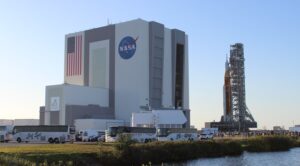NASA to award demonstrations of commercial satellite services to replace TDRS
Tuesday, 19 April 2022 12:48
NASA expects to make awards this spring in the next phase of its effort to transition from operating its decades-old network of communications satellites to purchasing commercial services.
The post NASA to award demonstrations of commercial satellite services to replace TDRS appeared first on SpaceNews.
India examining crashed space debris suspected to be parts of China’s Long March rocket
Tuesday, 19 April 2022 11:16
India’s space agency is examining a large metal ring and a cylinder-like object that fell into rural western India April 2, with a preliminary investigation suggesting they could be parts of a Chinese space rocket’s upper stage that reentered the atmosphere that day.
Op-ed | Get the Bullseye Off GPS
Tuesday, 19 April 2022 11:00
Protecting GPS satellites and signals is essential to U.S. national and economic security. While some have opined that the solution is more and better GPS, the most effective and least expensive solution is to make GPS a much less attractive target.
Safe ISS operation should remain priority, Space Foundation says
Tuesday, 19 April 2022 08:42 All countries participating in the International Space Station (ISS) project should focus on maintaining its safety and continued work, and keep in mind the long history of cooperation, as Russia is reviewing the future of its participation after sanctions, Space Foundation CEO Tom Zelibor told Sputnik.
In March, Roscosmos Director General Dmitry Rogozin said the Russian space agency will
All countries participating in the International Space Station (ISS) project should focus on maintaining its safety and continued work, and keep in mind the long history of cooperation, as Russia is reviewing the future of its participation after sanctions, Space Foundation CEO Tom Zelibor told Sputnik.
In March, Roscosmos Director General Dmitry Rogozin said the Russian space agency will Russian cosmonauts activate robotic arm on ISS during spacewalk
Tuesday, 19 April 2022 08:42 Two Russian cosmonauts aboard the International Space Station on Monday completed the first of two spacewalks to activate the station's new European Robotic Arm.
Cosmonauts Oleg Artemyev and Denis Matveev left the Russian Nauka module at 11:00 a.m. EDT to install the automated arm's control panel, finishing up their work and returning to the ISS around 5:48 p.m. EDT.
NASA's websi
Two Russian cosmonauts aboard the International Space Station on Monday completed the first of two spacewalks to activate the station's new European Robotic Arm.
Cosmonauts Oleg Artemyev and Denis Matveev left the Russian Nauka module at 11:00 a.m. EDT to install the automated arm's control panel, finishing up their work and returning to the ISS around 5:48 p.m. EDT.
NASA's websi Shenzhou XIII mission a success in testing tech for space station
Tuesday, 19 April 2022 08:42 The Shenzhou XIII mission has concluded the technology demonstration phase in the construction of China's Tiangong space station, according to a senior space official.
Hao Chun, head of the China Manned Space Agency, told a news conference in Beijing on Sunday that the phase, which included the deployment of Tiangong's core module and two manned spaceflights, has laid a solid foundation fo
The Shenzhou XIII mission has concluded the technology demonstration phase in the construction of China's Tiangong space station, according to a senior space official.
Hao Chun, head of the China Manned Space Agency, told a news conference in Beijing on Sunday that the phase, which included the deployment of Tiangong's core module and two manned spaceflights, has laid a solid foundation fo China reveals missions of Shenzhou-14, Shenzhou-15 space crews
Tuesday, 19 April 2022 08:42 The crews of China's Shenzhou-14 and Shenzhou-15 missions have been selected, and are carrying out relevant training and mission preparations, according to a press conference on Sunday.
Both crews will stay in orbit for six months, and they will for the first time rotate in orbit to realize the uninterrupted manned residence, Huang Weifen, chief designer of the China manned space program's
The crews of China's Shenzhou-14 and Shenzhou-15 missions have been selected, and are carrying out relevant training and mission preparations, according to a press conference on Sunday.
Both crews will stay in orbit for six months, and they will for the first time rotate in orbit to realize the uninterrupted manned residence, Huang Weifen, chief designer of the China manned space program's Core module of China's space station achieves anticipated goal
Tuesday, 19 April 2022 08:42 Tianhe, the core module of China's space station, has completed its verification of key technologies and achieved its expected goal.
Yang Hong, chief designer of the space station system of the China Manned Space Program at the China Academy of Space Technology, made the remarks at a press conference in Beijing on Sunday.
Yang said the core module has been in orbit for almost one y
Tianhe, the core module of China's space station, has completed its verification of key technologies and achieved its expected goal.
Yang Hong, chief designer of the space station system of the China Manned Space Program at the China Academy of Space Technology, made the remarks at a press conference in Beijing on Sunday.
Yang said the core module has been in orbit for almost one y Planet releases slew of datasets for planetary variables
Tuesday, 19 April 2022 08:42 Planet Labs PBC has announced the release of Planetary Variables, a new product offering consisting of three pre-processed, accurate data feeds that measure the conditions of dynamic systems on the surface of the Earth. The three Planetary Variables feeds consist of Soil Water Content, Land Surface Temperature, and Vegetation Biomass Proxy to help customers make informed decisions in industries
Planet Labs PBC has announced the release of Planetary Variables, a new product offering consisting of three pre-processed, accurate data feeds that measure the conditions of dynamic systems on the surface of the Earth. The three Planetary Variables feeds consist of Soil Water Content, Land Surface Temperature, and Vegetation Biomass Proxy to help customers make informed decisions in industries SpaceX launches second U.S. reconnaissance satellite on Falcon 9 rocket
Tuesday, 19 April 2022 08:42 SpaceX on Sunday successfully launched a U.S. spy satellite for the National Reconnaissance Office on its Falcon 9 rocket.
The company announced liftoff in the launch from the Vandenberg Space Force Base in California at 9:14 a.m.
The Falcon 9 carried the NROL-85 satellite that is used to collect and deliver "space-based intelligence, surveillance and reconnaissance," the office
SpaceX on Sunday successfully launched a U.S. spy satellite for the National Reconnaissance Office on its Falcon 9 rocket.
The company announced liftoff in the launch from the Vandenberg Space Force Base in California at 9:14 a.m.
The Falcon 9 carried the NROL-85 satellite that is used to collect and deliver "space-based intelligence, surveillance and reconnaissance," the office 100 km, the current Longest Distance of Quantum Secure Direct Communication
Tuesday, 19 April 2022 08:42 Confidentiality of communication is essential in modern societies. Traditional way of secure communication is to use encryption, which is based on the computational difficulty of certain mathematical problems such as factorizing large integers. In such schemes, the two parties first distribute a key using an asymmetric cryptographic algorithm such as RSA, which is based on the difficulty of inte
Confidentiality of communication is essential in modern societies. Traditional way of secure communication is to use encryption, which is based on the computational difficulty of certain mathematical problems such as factorizing large integers. In such schemes, the two parties first distribute a key using an asymmetric cryptographic algorithm such as RSA, which is based on the difficulty of inte NASA moon rocket headed back to Vehicle Assembly Building after testing delays
Tuesday, 19 April 2022 08:42 The launch of NASA's new moon rocket has been pushed back by nearly a month after the Space Launch System failed to complete necessary prelaunch testing, officials said Monday.
With the rocked estimated to lift off sometime between June 6 and June 16, NASA officials said that launching during that window now would be challenging after issues during the SLS's wet dress rehearsal prevente
The launch of NASA's new moon rocket has been pushed back by nearly a month after the Space Launch System failed to complete necessary prelaunch testing, officials said Monday.
With the rocked estimated to lift off sometime between June 6 and June 16, NASA officials said that launching during that window now would be challenging after issues during the SLS's wet dress rehearsal prevente Perseverance at the Delta
Tuesday, 19 April 2022 08:42 Last week's blog talked about the rapid traverse of Perseverance to the Delta. This weeks blog entry will talk about the Delta itself, and why it is something worth rapidly traversing towards!
The prospect of the delta for me is that every day will be full of excitement and could bring anything. Let me explain that a bit further. On a space mission like M2020 you get used an exciting timel
Last week's blog talked about the rapid traverse of Perseverance to the Delta. This weeks blog entry will talk about the Delta itself, and why it is something worth rapidly traversing towards!
The prospect of the delta for me is that every day will be full of excitement and could bring anything. Let me explain that a bit further. On a space mission like M2020 you get used an exciting timel Navy conducts historic test of new laser weapon system
Tuesday, 19 April 2022 08:42 The ground-based laser system homed in on the red drone flying by, shooting a high-energy beam invisible to the naked eye. Suddenly, a fiery orange glow flared on the drone, smoke poured from its engine and a parachute opened as the craft tumbled downward, disabled by the laser beam.
The February demonstration marked the first time the U.S. Navy used an all-electric, high-energy laser weap
The ground-based laser system homed in on the red drone flying by, shooting a high-energy beam invisible to the naked eye. Suddenly, a fiery orange glow flared on the drone, smoke poured from its engine and a parachute opened as the craft tumbled downward, disabled by the laser beam.
The February demonstration marked the first time the U.S. Navy used an all-electric, high-energy laser weap Schedule effects of SLS rollback still uncertain
Tuesday, 19 April 2022 00:23
NASA managers said a rollback of the Space Launch System from its launch pad after three truncated countdown tests will allow them to address issues both at the pad and with the vehicle, but that it was too early to predict what it would do to the schedule for the vehicle’s first launch.

